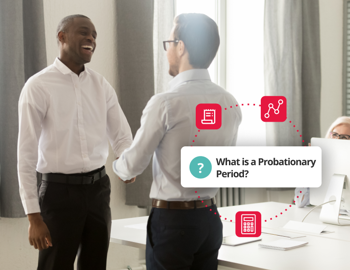
Hiring a new employee is a significant investment, especially for small to medium businesses. Not only must you ensure that you have found the right candidate with the necessary skills for the job, but that they also fit seamlessly into your team. That's where the probation period comes in.
In this article, we cover everything you need to know about probation periods, including:
- What exactly is probation, and why should you use them?
- What happens during this period?
- Can a probation be extended?
- How can you ensure a successful probation period?
By understanding the value and processes involved in a probation period, you can utilise the time effectively and make informed decisions about your new team members whilst creating a positive onboarding experience.
What is a probation period?
A probation period is a set timeframe at the start of employment. It is a trial period for both you and your new employee, usually lasting between one to six months. During a this time you can assess if a new hire fits the role and company culture.
These periods are also beneficial for internal promotions. When an existing employee moves into a new position, they may have a probationary period. This lets companies assess the employee's ability to handle their new duties. It also ensures a smooth transition for both the employee and the team.
What happens during a probation period at work?
1. Training and support
During the probation period, employers must provide comprehensive training for new hires. This ensures that the employee is equipped with the knowledge and skills to excel in their role.
Training can encompass various formats, but eLearning is a popular choice amongst businesses. eLearning modules allow employees to learn at their own pace. They can revisit if needed, which helps build a strong foundation of knowledge.
2. Goal setting
To ensure everyone is on the same page, employers and employees will work together to set SMART goals. These goals are clear benchmarks for evaluating the employee's performance. By focusing on these specific goals, the new hire can show their skills and progress. The employer gains insight into their capabilities.
3. Feedback
Regular feedback is the foundation of a successful probation period. Managers should provide constructive feedback highlighting both their triumphs and any areas that may need to be addressed. This feedback ensures the employee is on the right track and build on areas for improvement.
4. Probation review
At the end of the probation period, a formal meeting should take place between the employee and their manager. This meeting is called a probation review and serves as a chance to:
- Review the employee's performance against the established goals
- Provide feedback on employee progress, strengths and areas requiring development
A final decision on the individual's continued employment is made during the meeting. Employers should maintain clear and accurate records of the employee's probation performance.
Extending or modifying probation periods
The set probation period isn't always a rigid timeframe. There may be circumstances where extending the probationary period becomes necessary, such as:
- Complexity of the role requiring more time to grasp
- Personal circumstances impacting ability to meet initial expectations
In such cases, employers have the option to extend the probation period. But it's crucial to ensure transparency throughout this process. Any extension should be communicated in writing, outlining the reasons for the extension.
This documentation should cover any revised goals and expectations, whilst protecting both parties.
What are the benefits of a probation period?
Probation periods are a valuable tool for both employers and employees.
For employers...
It offers the chance to gain insight into an employee's skills, work ethic and fit within the team. This allows the employer to make flexible and informed decisions on new hires, improving the hiring process.
For employees...
A probation period provides time to adjust to their new role and get familiar with what is expected of them. Employees can also get to know the company’s working style and culture. Furthermore, the goal-setting process that occurs during probation sets clear benchmarks for success. This helps them to focus their efforts, gauge progress and identify areas to improve.
Ultimately, the probation period allows both the employee and the employer to assess if the working relationship is a good fit.
Ensuring a successful probation period
1. Set clear expectations
Establishing clear expectations from the outset is paramount. This transparency allows employers to accurately measure an employee's performance against defined benchmarks. By outlining these expectations collaboratively, employers can ensure everyone is on the same page.
2. Onboard effectively
Following a well-structured onboarding process is crucial. This is especially true for new hires unfamiliar with the industry. The probation period sets the tone for the employee's experience and provides the tools necessary to succeed.
Having an onboarding process in place can reduce the learning curve and help settle them into their new role from the get-go.
3. Training and development
Providing ongoing training opportunities throughout the probation period is essential for employee growth. This helps them to develop the skills necessary for their role and work towards their goals. Investing in a new hire's development will help them reach their full potential within the company.
4. Provide regular feedback
Regular feedback is the cornerstone of a successful probation period. Just like ongoing training, consistent guidance is essential for an employees development. Managers should provide constructive feedback throughout the probationary period.
Feedback should:
- highlight areas where the employee excels
- Offer support to address any challenges they may encounter
- allow employees to course-correct if needed and ensure they are on the right track
For a more comprehensive approach, consider incorporating 360-degree feedback during the probation period.
This method gathers feedback from various sources, including colleagues, peers, and even clients. By getting feedback from a wider range of people, employers can get a clearer picture of the employee's skills and how well they fit the role and the team.
5. Give employees a chance to improve
Helping the employee improve on any weaknesses is good for both the company and the employee. It empowers the employee to take ownership of their growth and demonstrates the company's investment in their success. This strengthens their skillset and leads to a more productive and engaged employee.
6. A clear timeline
Establishing a clear timeline for the probation period provides the employee great visibility. The timeline should outline what's expected at different stages and when they can expect check-ins with their manager. This transparency helps the employee focus their efforts and track their progress throughout the probationary period.
Nurture new talent with performance management software
When it comes to recruitment, finding the right fit is crucial. A Probation period allows you to assess a new employees performance, work ethic, and team fit. This means setting clear goals, providing training, and giving regular feedback.
Managing probation periods can be tricky, especially for small businesses. However, having the right HR software can help by setting and tracking goals, providing and storing feedback electronically, and keeping all employee records in one place.
To learn more about our HR Performance Management Software, contact us today or enjoy a free trial.
